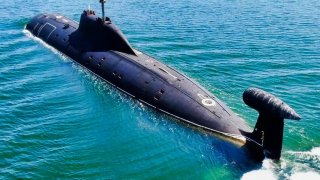Russia's Sierra-Class II Titanium Submarines Are a Giant Mystery
The Soviet Union didn't build additional Sierra II-Class or what is also called Project 945A Kondor Class submarines due to the high cost of the materials, and the difficulties in working with titanium.
Project 945A Kondor Class – Sierra II-Class Submarine - Since the first major building program of 1926, the Soviet Navy had laid great emphasis on submarine construction. This was originally due to the defensive role planned for the fleet, and later because the widely dispersed submarine yards were the only ones to survive the German attacks during the Second World War.
The first boats to be built in the Soviet Union were little more than improved editions of those built prior to the First World War, and that trend continued until the 1950s – when the Kremlin sought to counter the submarine capabilities of the West.
In the 1960s, the Soviet Union developed the Project 661 "Anchar" (NATO reporting name "Papa-Class"), a nuclear-powered cruise-missile submarine that was upon completion the world's fastest submarine. It was also the first to be built with a titanium hull. While fast, it was noisy; and it was soon determined that its flaws outweighed its advantages. However, it pioneered the technology needed to work with titanium on a large scale, which enabled the subsequent construction of more successful designs using titanium
This led to the development of more advanced submarines – notably Project 945 Barrakuda and Project 945A Kondor, (NATO reporting names Sierra I and Sierra II respectively). These boats were distinct for their titanium hulls, which allowed the submarines to dive to greater depths while reducing the emission of radiated noise and increasing resistance to torpedo attacks.
Sierra II-Class: Enter the Project 945A Kondor
The Sierra II Class, also known as Project 945A Kondor Class, remains among the Russian Navy's most expensive and deep-diving submarines. The boats were specifically developed for search and destroy missions against U.S. nuclear-powered ballistic missile submarines.
A follow-up to the Sierra I, the class was unique due to its light and strong titanium twin-pressure hulls, which featured space in between. That enabled the boats to dive to greater depths, while it reduced the level of radiated noise and increased resistance to torpedo attacks. Like the original Project 945 Barrakuda, the Project 945A boats were powered by a single OK-650 pressurized water reactor, rated at 190 MW.
It had greater speed and diving depth than its American counterparts at the time it was designed and would have been a serious threat if the Cold War turned hot. Two of the submarines were completed – the Pskov (ex-Zubatka) and Nizhny Novgorod (ex-Okun) – and both remain operational with the Russian Navy's Northern Fleet. A third of the class, Mars, was laid down in 1990. That boat was built to an improved Project 945B (NATO designation Sierra III class), but it was scrapped before completion in 1992.
Was the Sierra II-Class a Failure for Russia?
The Soviet Union didn't build additional Sierra II-Class or what is also called Project 945A Kondor Class submarines due to the high cost of the materials, and the difficulties in working with titanium.
As previously reported, to successfully weld huge titanium panels on a large scale, Soviet engineers had to first create enormous warehouses that were hermetically sealed and then filled with argon, an inert gas that would not interfere with the welding process. Welders had to wear a large cosmonaut-like suit that would supply them with oxygen while inside these warehouses.
Titanium is also rare and costly compared to iron, while it isn't exactly easy to shape either. Any misstep by the welders would create a sub that would be dangerous to take on deep dives. The higher pressure could compromise the weakened hull.
No News – Good News?
While Moscow regularly touts the capabilities of its military vessels, there has been surprisingly little said of the two Project 945A Kondor Class submarines in recent years
A November 2019 report from state media outlet Tass noted that the Nizhny Novgorod and Pskov held an underwater duel with torpedo practice fire in drills.
"The crews of the Northern Fleet's multipurpose nuclear-powered submarines Nizhny Novgorod and Pskov performed planned assignments in the Barents Sea… Torpedo practice fire against surface targets was the most complex and responsible stage of the joint underwater maneuvers. The crews of the Northern Fleet's multipurpose nuclear-powered submarines Nizhny Novgorod and Pskov performed this exercise in the duel version," the press office of the Russian Navy's Northern Fleet announced in a statement.
The submariners further were reported to have practiced combat maneuvering with their switchover to an attacking position and breaking from the enemy force by way of jamming and setting up dummy targets, according to the statement.

However, in the more than four years that followed there has been virtually no mention of the boats – and while they officially remain in service, it is believed both rarely leave port.
Author Experience and Expertise
Peter Suciu is a Michigan-based writer. He has contributed to more than four dozen magazines, newspapers, and websites with over 3,200 published pieces over a twenty-year career in journalism. He regularly writes about military hardware, firearms history, cybersecurity, politics, and international affairs. Peter is also a Contributing Writer for Forbes and Clearance Jobs. You can follow him on Twitter: @PeterSuciu.
Main image is a generic picture of a Russian Submarine that is Creative Commons. The intext image is also Creative Commons but of an actual Sierra-Class submarine.


